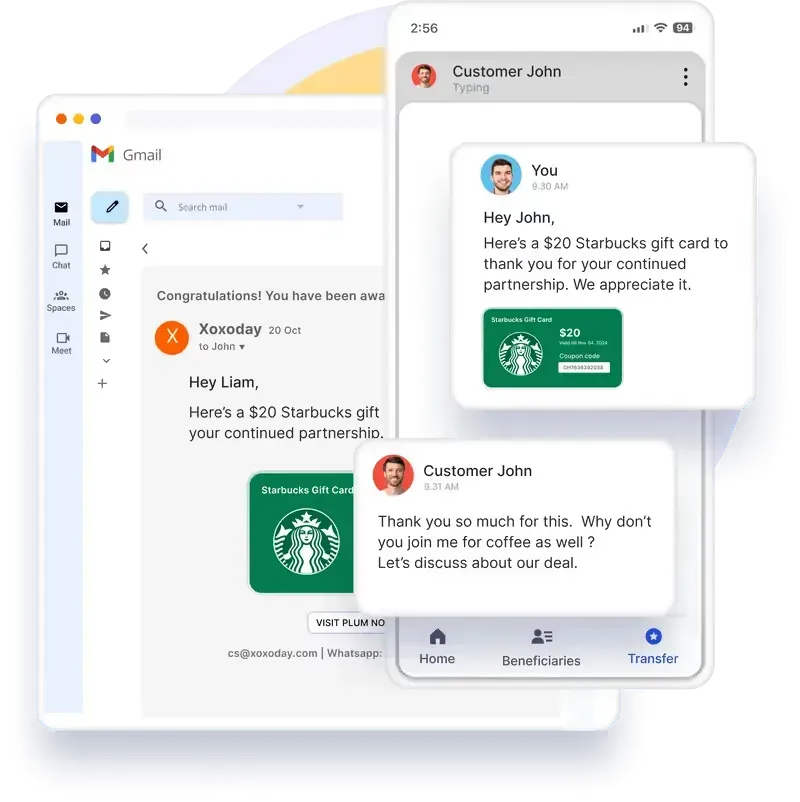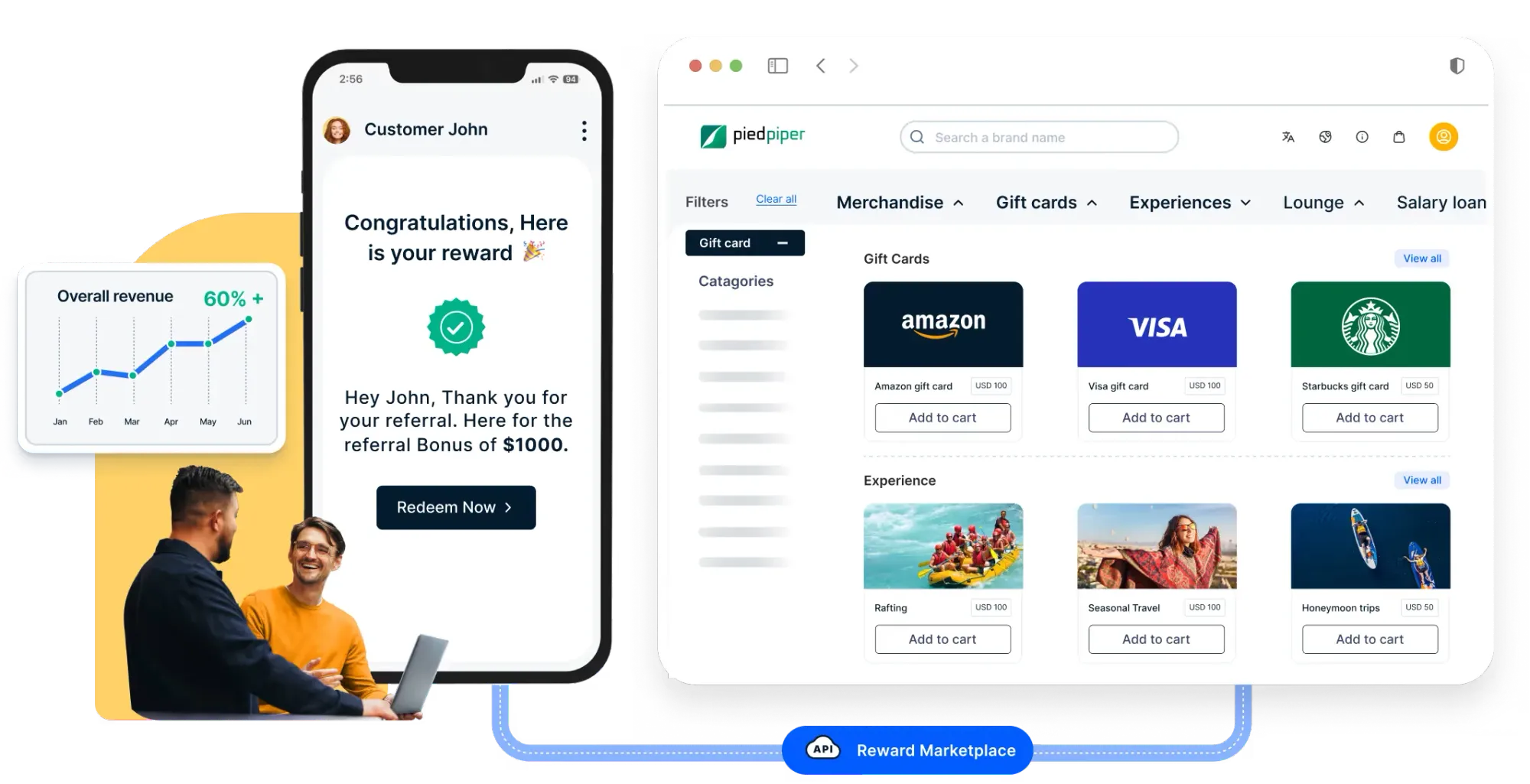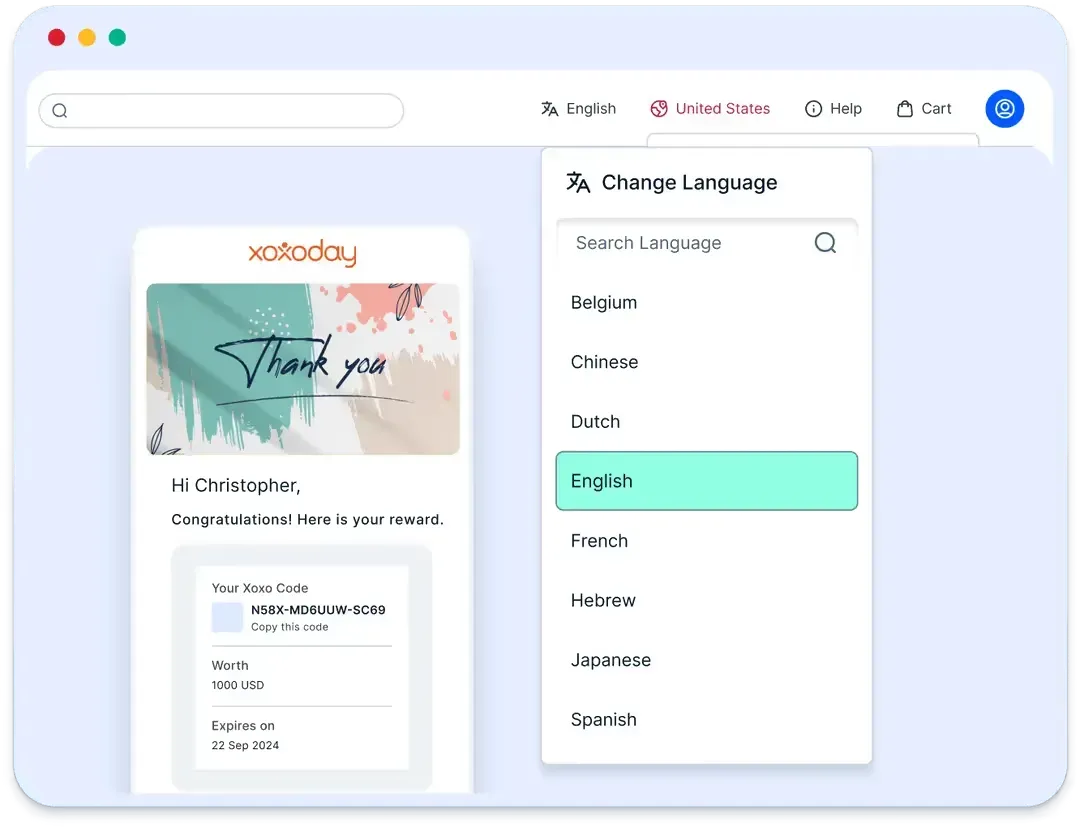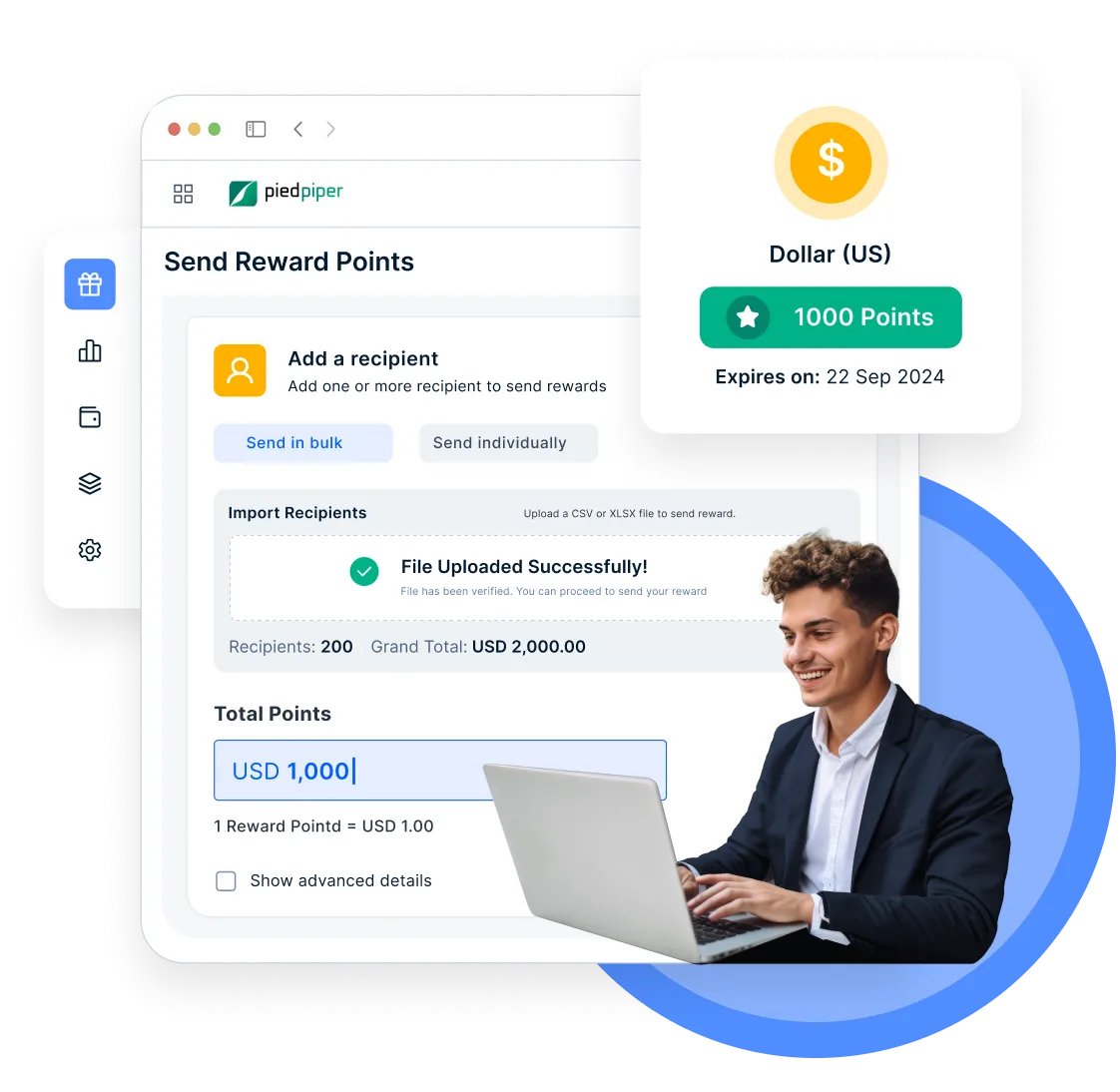ما هو تسويق المكافآت وكيفية استخدامه لاكتساب العملاء وولائهم والاحتفاظ بهم
التسويق بالمكافآت هو أحد أكثر الطرق فعالية لإشراك عملائك. ستتحدث هذه المدونة أكثر عن كيفية استخدام التسويق بالمكافآت وكيف يمكن أن يساعدك.
في هذه الصفحة
إن برامج المكافآت في التسويق ناجحة ولسنا مضطرين للنظر بعيدًا جدًا لنجد الدليل على ذلك. دراسة حديثةدراسة حديثةأن 82.4% من العملاء يميلون إلى التسوق أكثر من المتاجر التي لديها شكل من أشكال برامج المكافآت. وهذا يثبت مدى فعالية استخدام التسويق بالمكافآت وكيف يمكن أن يساعدك في التفوق على منافسيك. تحاول هذه المدونة أن تتعمق في هذه المدونة وتكتشف الأعمال الداخلية لاستراتيجية التسويق المعنية - ما هو التسويق بالمكافآت وكيف يمكن أن يساعد؟
ما هو التسويق بالمكافأة؟
تسويق المكافآت هو الاستخدام الاستراتيجي للحوافز لحثّ الجمهور المستهدف على اتخاذ إجراءات قيّمة - سواء كانوا عملاء أو شركات تابعة أو مؤثرين أو موظفين. يمكن أن تتراوح هذه الإجراءات من إجراء عملية شراء أو اشتراك أو إحالة الأصدقاء إلى ترك التعليقات أو مشاركة المحتوى.
الفكرة بسيطة: تقديم مكافأة مقنعة لتشجيع السلوك الذي يعود بالنفع على العلامة التجارية، وغالبًا ما يكون ذلك أكثر فعالية من حيث التكلفة من طرق التسويق التقليدية المدفوعة.
كيف يمكن أن يساعد برنامج المكافآت في التسويق بالمكافآت؟
برنامج المكافآت له نطاق واسع حيث يمكن استخدامه لخلق مشاركة أفضل مع - الموظفين من خلال مكافآت الموظفين، وشركاء القنوات، والعملاء من خلال برامج المكافآت والولاء المختلفة (أي شيء يتعلق ببناء علاقة إنسانية).
يعمل برنامج المكافآت بمثابة المحرك الذي يدعم التسويق بالمكافآت من خلال إنشاء طرق منظمة وقابلة للتكرار والقياس لتحفيز سلوك العملاء. فبدلاً من تقديم خصومات لمرة واحدة أو امتيازات عشوائية، يتيح برنامج المكافآت للعلامات التجارية تشجيع الإجراءات التي تتوافق مع أهداف أعمالهم بشكل منهجي - مثل الاشتراك أو تكرار الشراء أو إحالة الأصدقاء.
عند تطبيق المكافآت في مجال التسويق، يمكن أن تساعدك المكافآت على -
- بناء الاتصالات
- زيادة ولاء العملاء
- تعميق المشاركة و
- جذب عملاء جدد

تسويق المكافآت هو ممارسة يمكنك من خلالها الاستفادة من برنامج المكافآت أو الولاء من خلال المشاركة في البرنامج. يتم ذلك من خلال تقديم مكافآت جذابة وجذابة.
كيف يساعدك التسويق بالمكافآت عبر مسار التسويق؟
الاستحواذ
اكتساب العملاء يعد أمرًا ضروريًا للشركات من أي عمر وحجم. إن القدرة على جذب عملاء جدد وتحويلهم بشكل منهجي يحافظ على صحة الشركات ونموها - ويسعد المستثمرين. ولكن كيف تفعل ذلك؟
ضع في اعتبارك تسويق المكافآت. يساعدك تسويق المكافآت على توفير هذا الشيء الإضافي - سواء كان ذلك حوافز أو ائتمانات أو هدايا مادية أو مكافآت مالية أو حتى مكافآت غير نقدية لعملائك. أفضل شيء في تسويق المكافآت هو خصائصه متعددة الأغراض. التسويق بالمكافآت ليس مجرد مسار تحويل أحادي الاتجاه ولكنه دولاب الموازنة يساعدك على اكتساب النوع المناسب من العملاء الذين سيستمرون في العمل.
احتباس:
إن بناء قاعدة عملاء جديدة أمر مكلف. وقد تختلف التكاليف باختلاف الصناعات. ولكن وفقاً لما ذكره مهدي خسرو-بور في كتابهكتابه"الاتجاهات والتحديات الناشئة في إدارة تكنولوجيا المعلومات"، فإناستبدال عميل جديد يكلف خمسة أضعاف تكلفة الاحتفاظ بعميل قديم.

الاتجاهات والتحديات الناشئة في مجال تكنولوجيا المعلومات
النهج الأفضل هو الحفاظ على العملاء الذين لديك، من خلال اختيار حوافز العملاء أو برامج تسويق المكافآت الذكية. سيساعدك هذا فيالاحتفاظ بالعملاءوجعلهم مخلصين لعلامتك التجارية. إن معرفة أن إجراء عملية شراء ثانية من علامتك التجارية سيكسب العملاء أكواد/قسائم قسائم للعملاء سيجعل منتجك أكثر جاذبية من منتجات منافسيك.
الإحالات:
من المزايا الأخرى للتسويق بالمكافآت أنه يمكن أن يساعدك على ترجيح كفة عميل محتمل لإجراء عملية شراء - خاصةً عندما تكون مدعومة بتوصية من صديق.مكافآت الإحالةتأتي في جميع الأشكال والأحجام، ولكن الحيلة تكمن في تقديم المكافآت التي تكمل تجربة علامتك التجارية وتلبي احتياجات عملائك. الطرق الأكثر شيوعًا هي -
- مكافأة كلا الطرفين برموز قسيمة قابلة للاسترداد عند الشراء التالي.
- مكافأة الموصي بنقاط إضافية.
- الابتكار في استخدام المنتجات المجانية
مناصرة العملاء:
مناصرة العملاء هي الطريقة التي تسمح للعلامات التجارية باكتساب عملاء جدد وقيّمين بشكل طبيعي. إن الموقف الإيجابي للعملاء تجاه منتجات/خدمات علامتك التجارية يقودهم إلى التوصية بها للآخرين بعد تجربتها بأنفسهم.
عملاؤكمؤيدو العملاءمدفوعون بشيء يسمى - SAPS (المكانة أو الوصول أو القوة أو الأشياء)، ويمكن للتسويق بالمكافآت أن يفعل ذلك. كما ترى، لا يقتصر التسويق بالمكافآت على تقديم الكوبونات والهدايا المجانية فحسب، بل هو إنشاء نظام بيئي يمكن للعملاء من خلاله مشاركة المعرفة والخبرة وجعل العملاء يشعرون بأن رأيهم مهم.
أنواع برامج تسويق المكافآت
تسويق المكافآت هو استراتيجية متعددة الاستخدامات تعزز مشاركة العملاء واكتسابهم وتأييدهم. سواء تم استخدامها لجذب عملاء جدد أو تحفيز الإحالات أو تعزيز الولاء للعلامة التجارية، يمكن لبرامج المكافآت أن تحفز الإجراءات الهادفة وتخلق قيمة طويلة الأجل. فيما يلي بعض الأنواع الرئيسية لبرامج التسويق بالمكافآت:
1. برامج الإحالة
التسويق بالإحالة يحول العملاء الراضين إلى مناصرين للعلامة التجارية، ويشجعهم على مشاركة علامتك التجارية مع الأصدقاء والعائلة والزملاء. تستفيد هذه الاستراتيجية الشفهية من روابط الإحالة والرموز والتلعيب لجعل المشاركة سهلة ومجزية.

وعادةً ما يتلقى المشاركون حوافز مثل الخصومات أو الأرصدة أو المكافآت النقدية عندما يكمل المُحالون إجراءً مرغوباً فيه - مثل التسجيل أو إجراء عملية شراء أو طلب عرض أسعار. تقوم بعض الشركات، مثل شركات التأمين، بتنظيم مكافآت متعددة المراحل، حيث تقدم حافزاً أولياً لتوليد عملاء محتملين وحافزاً آخر عند التحويل.
2. حملات اكتساب العملاء القائمة على المكافآت
تستخدم العلامات التجارية الحوافز المالية بشكل متزايد لجذب عملاء جدد، مثل:
"سجّل اليوم واحصل على مكافأة قدرها 50 دولارًا!" أو "بدّل حسابك واحصل على 200 دولار نقدًا!"
وغالباً ما تقدم هذه الحملات نقداً بطاقات هداياأو قسائم تجذب المستهلكين دون التقليل من القيمة المتصورة للمنتج - على عكس استراتيجيات الخصم التقليدية. قد تنشر الشركات هذه العروض الترويجية من خلال الإعلانات الرقمية أو رموز الاستجابة السريعة أو الحملات محدودة الوقت عبر قنوات مختلفة لاكتساب العملاء.
3. تسويق الشراكات
بالإضافة إلى إحالات العملاء، يمكن للشراكات مع الشركات التابعة والمؤثرين والعلامات التجارية الأخرى إنشاء قناة تسويقية عالية التأثير. من خلال الاستفادة من الشركاء الموثوق بهميمكن للشركات توسيع نطاق وصولها مع الحفاظ على التحكم في رسائل العلامة التجارية والحوافز القائمة على الأداء.
يمكن للشركاء استخدام هياكل مكافآت مماثلة - خصومات أو هدايا حصرية أو استرداد نقدي - لتحفيز إجراءات العملاء، مما يجعل التسويق بالشراكة طريقة فعالة وقابلة للتطوير لاكتساب العملاء.
4. برامج مناصرة العملاء
تشجيع العملاء على ترك مراجعات أو مشاركة الشهاداتأو إنشاء محتوى عن علامتك التجارية يعزز المصداقية والثقة. وبالنظر إلى أن أكثر من 70% من المستهلكين يتحققون من المراجعات عبر الإنترنت قبل الشراء، فإن برنامج التأييد النشط يمكن أن يعزز التحويلات بشكل كبير.

إن تحفيز العملاء بمكافآت لترك مراجعات حقيقية أو نشر صور المنتجات أو مشاركة التجارب على وسائل التواصل الاجتماعي يزيد من المشاركة. ومع ذلك، يجب أن تضمن العلامات التجارية الشفافية والامتثال لسياسات المراجعات للحفاظ على المصداقية.
5. حوافز المشاركة المجتمعية ودعم العملاء
تستفيد بعض العلامات التجارية من قوة مجتمعاتها لتوفير دعم العملاء ومشاركتهم. على سبيل المثال، تكافئ GiffGaff المستخدمين الذين يساعدون في الإجابة عن الأسئلة التقنية ودعم العملاء الآخرين في المنتديات.
من خلال التلعيب في المشاركة المجتمعية-تقديم النقاطأو امتيازات حصرية أو عضويات متميزة - يمكن للشركات تحويل العملاء المخلصين إلى مساهمين قيّمين في العلامة التجارية، مما يعزز التعاون ويقلل من التكاليف التشغيلية.

6. برامج إحالة الموظفين
يمكن لموظفيك أن يكونوا دعاة أقوياء لعلامتك التجارية. برامج إحالة الموظفين مكافأة أعضاء الفريق على تقديم منتجاتك أو خدماتك لشبكاتهم الشخصية.
على سبيل المثال، يمكن أن يحصل الموظفون على مكافآت أو امتيازات عندما يشترك من يحيلونهم إلى خدمة ما أو يقومون بعملية شراء. لا يؤدي ذلك إلى زيادة المبيعات فحسب، بل يعزز أيضاً من مشاركة الموظفين من خلال منحهم فرصة لمشاركة الصفقات القيمة مع أصدقائهم وعائلاتهم.
7. امتيازات الموظفين وبرامج التقدير
تماماً كما أن ولاء العملاء أمر حيوي، فإن الاحتفاظ بالموظفين وتحفيزهم وتحفيز الموظفين على نفس القدر من الأهمية. يمكن لبرامج المكافآت المصممة للموظفين أن تعزز الروح المعنوية والأداء والالتزام على المدى الطويل.
يمكن للشركات تقديم مكافآت مالية، أو أيام إجازات إضافية، أو امتيازات شخصية، أو تجارب حصرية لتقدير المساهمات المتميزة. الاستثمار في مكافآت الموظفين يعزز ثقافة التقدير ويعزز الرضا العام في مكان العمل.
8. النظام القائم على النقاط
هذا نوع من برامج المكافآت التي تتيح للعملاء بجمع النقاط التي يمكن استبدالها على مختلفالمنتجات/الخدمات المختلفة. وهي أسهل بكثير في الإعداد، مما يجعلها أكثر أنواع برامج الاحتفاظ بالعملاء شيوعًا.
قد تجد العديد من شركات التجارة الإلكترونية التي تكافح للحصول على عملاء في الباب الافتراضي حلاً في هذا النوع منبرنامج الولاء.هناك طرق مختلفة يمكن للعميل من خلالها كسب هذه النقاط. على سبيل المثال - المشاركة على مواقع التواصل الاجتماعي، أو التعويض عن التظلمات، أو رسائل البريد الإلكتروني، أو أي إجراءات أخرى تقوم بها لجذب الزبائن إلى موقعك.
9. برنامج المشتري المتكرر
إنها أداة ممتازة للحفاظ على الولاء للعلامة التجارية. عادةً ما تكون في شكل بطاقة هدايا أو قسيمة أو خصومات أو هدايا مجانية أو معاملة خاصة للعملاء. وعادةً ما يتم منحها للعملاء الذين يأتون إلى موقعك أو متجرك ويضغطون على "شراء" بشكل متكرر.
إنه برنامج سهل وشائع الاستخدام للاحتفاظ بالعملاء لكل من الشركات التقنية (أمازون وفيكتوريا سيكريتس) وغير التقنية (المقاهي ومحطات الوقود).
10. التلعيب
التلعيب ليس تكتيكًا جديدًا في مجال التسويق. فقد دأبت الشركات على ابتكار تجارب لعبة في بيئة غير الألعاب لزيادة المبيعات. سيظل التلعيب مناسبًا دائمًا لأنه يلعب على الغرائز التنافسية الطبيعية للأشخاص، لتحفيز العمل والتأثير على خيارات المشتري.
يمكن استخدام هذا النوع من البرامج لاكتساب العملاء والاحتفاظ بهم. هناك عناصر مختلفة للتلعيب وكل منها يؤدي إلى نتيجة مختلفة -
- توفر نقاط المكافآت القابلة للاستردادردود الفعل التي تغذي حاجة العميل إلى الإشباع الفوري.
- الشاراتمثل رموز الحالة المرئية. فهي تؤثر على السلوك الذي يحفز العميل على التفاعل مع علامتك التجارية بشكل أكبر، لكسب المزيد من الشارات.
- المعالم الرئيسيةتكشف عن رحلة نجاح العميل مع علامتك التجارية. فهي تلهم الشعور بالإنجاز والمزيد من المنافسة.
- يمكن استخدام الصور الرمزيةلإنشاء سياق سردي. فهي تتيح للعملاء أن يصبحوا جزءًا من المجتمع، مما يثير المزيد من الاهتمام.
11. المسابقة/الجوائز
المسابقات/المراهنات مصممة لتلبية حاجة الإنسان إلى الفوز. لا فائدة من الفوز إذا لم تكن هناك مكافأة. ومع ذلك، تختلف طريقة تحديد الفوز في كل من المسابقات واليانصيب. في مسابقات اليانصيب يتم اختيار الفائزين عن طريق الحظ.
يمكن أن تتراوح الجوائز ما بين - ملصقات، وقمصان، ومنازل، وسيارات، وجوائز نقدية ضخمة. إنها طريقة رائعة لاكتساب عملاء جدد. من ناحية أخرى، تستقطب المسابقات الفائزين على أساس بعض الجدارة. في مثل هذه الحالات، تكون الجائزة أيضًا شيئًا يكسب اهتمام العملاء ويحفزهم على الاشتراك في المسابقة. هذه أداة مفيدة للاحتفاظ بالعملاء الذين هم بالفعل جزء من قاعدتك المستهدفة. تشكل المسابقة واليانصيب معاً قوة لا يستهان بها. فهي لا تولد الاهتمام فحسب، بل تساعد أيضًا في توسيع نطاق وصولك إلى جمهور مستهدف أكبر.
12. مراجعات المنتجات
يستخدم قطاع التجارة الإلكترونية عادةً هذا النوع من التسويق بالمكافآت. يمكن للعملاء التقييم والتعليق على المنتجات التي اشتروها على صفحة المنتج. ويمكن للمستهلكين الآخرين قراءة الملاحظات عند اتخاذ قرار الشراء. ومع ذلك، فإن حث العملاء على مشاركة ملاحظاتهم الإيجابية ليس بالأمر السهل.
ما الفائدة لهم؟
إنه وضع يربح فيه الجميع لأن -
- يؤدي ذلك إلى زيادة عدد الزيارات، حيث يعود العملاء لاسترداد نقاطهم.
- تساعد تقييماتهم ومراجعاتهم العملاء الجدد في اتخاذ قرار الشراء الحاسم.
كيفية اختيار المكافآت المناسبة للتسويق بالمكافآت
اختيار المكافآت المناسبة أمر بالغ الأهمية لضمان نجاح أي مبادرة تسويق بالمكافآت. فسواء كنت تركز على اكتساب عملاء جدد أو تشجيع الولاء أو تعزيز الاحتفاظ بالعملاء، يجب أن تتوافق استراتيجية المكافآت الخاصة بك مع تفضيلات الجمهور والإجراء المطلوب وهوية علامتك التجارية.
إليك إطار عمل شامل لمساعدتك في اتخاذ الخيارات الصحيحة:
1. تحديد الهدف من حملة المكافآت
ابدأ بتحديد الإجراء الذي تريد أن يتخذه جمهورك. يجب أن يتوافق نوع المكافأة التي تقدمها بشكل مباشر مع هدفك التسويقي.
- لاكتساب العملاء: اختر المكافآت التي تثير الاهتمام الفوري وتحفز التحويلات لأول مرة. على سبيل المثال، بطاقة هدايا إلكترونية من ستاربكس بقيمة 10 دولارات للمستخدمين الجدد الذين يكملون عملية التسجيل أو يقومون بتنزيل تطبيقك.
- للاستبقاء: ركز على الحوافز التي تبني العادات وتشجع على تكرار الاستخدام. فكر في رصيد اشتراك بقيمة 25 دولاراً بعد الطلب الشهري الثالث.
- للولاء: قدِّم امتيازات عالية القيمة مدفوعة بالمكانة التي تعمق التقارب مع العلامة التجارية، مثل الوصول إلى تجربة متميزة أو الوصول الحصري المبكر إلى المنتجات التي يتم إسقاطها.
2. افهم جمهورك
اختر المكافآت التي تعكس أسلوب حياة جمهورك وقيمه وسلوكياته. أحد أكبر الأخطاء في تسويق المكافآت هو افتراض أن جميع العملاء لديهم نفس الدوافع.
- بالنسبة لجيل الألفية الحضري أو الجيل Z: المكافآت الرقمية الشائعة مثل Netflix أو Uber Eats أو بطاقات هدايا DoorDash التي تناسب أسلوب حياتهم الذي يعتمد على الراحة.
- للمحترفين: تعمل مكافآت الصحة والإنتاجية مثل اشتراكات Headspace أو أرصدة Audible أو بطاقات هدايا Apple بشكل جيد.
- للمستهلكين ذوي الوعي الاجتماعي: السماح لهم بتحويل النقاط إلى تبرعات خيرية (على سبيل المثال، من خلال منصات مثل DonorsChoose أو Feeding America).
قم بإجراء استبيانات أو تحليل شخصيات المشترين أو الاستفادة من البيانات الديموغرافية لفهم ما يحفز جمهورك المستهدف.
3. مطابقة قيمة المكافأة مع الإجراء المتخذ
يجب أن تكون قيمة المكافأة متناسبة مع جهد المستخدم أو التزامه. إذا كان الإجراء يتطلب المزيد من الوقت أو المال من العميل، فيجب أن تعكس المكافأة ذلك.
- إجراء منخفض الجهد (مثل الاشتراك في البريد الإلكتروني): تقديم مكافآت صغيرة منخفضة التكلفة ولكن ذات مغزى مثل بطاقة هدايا إلكترونية من دانكن بقيمة 5 دولارات.
- إجراء عالي الجهد (مثل الاشتراك أو الشراء): استخدم حوافز ذات قيمة أعلى مثل بطاقة هدايا من Best Buy بقيمة 50 دولاراً أو حزمة بضائع ذات علامة تجارية.
يضمن هذا النهج أن تبدو المكافأة مناسبة وجديرة بالاهتمام، مما يزيد من احتمالية التحويل.
4. تقديم التخصيص والاختيار
السماح للعملاء باختيار مكافآتهم يزيد من رضاهم ومشاركتهم. فنادراً ما ينجح نهج "مقاس واحد يناسب الجميع"، خاصةً مع قواعد العملاء المتنوعة.
- توفير إمكانية الوصول إلى كتالوج المكافآت الرقمية بخيارات واسعة النطاق، مثل البيع بالتجزئة (تارغت، وول مارت)، أو تناول الطعام (شيبوتل، وغروب هاب)، أو السفر (خطوط دلتا الجوية، وإير بي إن بي)، أو الصحة (كلاس باس، وكالم).
- استخدم التقسيم إلى شرائح لتخصيص المكافآت لشخصيات العملاء المختلفة - الأمهات الجدد، والمسافرين الدائمين، وعشاق التكنولوجيا، وغيرهم.
المكافآت المخصصة تجعل علامتك التجارية تبدو أكثر إنسانية وتزيد من التواصل العاطفي.
5. ضمان سهولة التسليم والاسترداد
إن أفضل المكافآت هي تلك التي يمكن الوصول إليها على الفور، وسهلة الاستخدام، ولا تتطلب القفز عبر الأطواق. يمكن لعملية الاسترداد المعقدة أن تقضي على حماس العملاء وتضعف نتائج الحملة.
- اختر المكافآت الرقمية بدلاً من المادية للتخلص من التأخير ومتاعب الشحن.
- استخدم بطاقات الهدايا المستندة إلى الروابط أو التي يتم تسليمها عبر البريد الإلكتروني من منصات مثل Xoxoday Plum لضمان الإشباع في الوقت الفعلي.
على سبيل المثال، تستخدم علامات تجارية مثل Dropbox و Instacart المكافآت الفورية للإحالات، مما يجعل العملية سلسة ومرضية.
6. مواءمة المكافآت مع هوية علامتك التجارية
مكافأتك هي نقطة اتصال لعلامتك التجارية. يجب أن تعزز شخصية علامتك التجارية ونمطها ووعودك. يمكن أن تؤدي المكافأة التي تبدو غير متزامنة مع علامتك التجارية إلى إرباك جمهورك أو تنفيره.
- إذا كنت علامة تجارية فاخرة لأسلوب الحياة: قدم تجارب متميزة مثل باقات السبا أو البضائع الحصرية أو تجارب الطعام الفاخرة.
- إذا كنت من العلامات التجارية المتقدمة تقنياً: قدم مكافآت ملائمة للأجهزة مثل أجهزة Amazon Echo أو ملحقات Logitech.
- إذا كانت الاستدامة هي جوهر علامتك التجارية: قم بتضمين أرصدة تعويض الكربون أو التبرع للمنظمات البيئية مثل منظمة الحفاظ على الطبيعة.
المفتاح هو استخدام المكافآت لتعزيز السرد الذي ترويه علامتك التجارية بالفعل.
نصائح لبناء برنامج مكافأة عملاء ناجح
يجب أن يكون برنامج المكافآت الذي يعمل بشكل مثالي مجزيا وجذابا ومحفزا. فيما يلي بعض النصائح التي يجب مراعاتها أثناء تشغيل برنامج تسويق المكافآت:
- اجعل المكافآت جذابة:قد يقوم العملاءبالتسجيل في برنامج المكافآت الخاص بك، ولكن هذا لا يعني دائماً الولاء. هل تعلم؟ فقط13%فقط من العملاء هم الموالون الكاملون. لذا، يجب أن يكون برنامج المكافآت الخاص بك جذاباً ومغرياً بما يكفي ليقوم العملاء بالتسجيل فيه واستخدامه بانتظام. على سبيل المثال، تفرض العديد من صالونات التجميل الراقية رسومًا على الأعضاء للانضمام ولكنها تقدم أيضًا كوبونات موسمية وشهرية بنفس المبلغ لتعويض تكلفة البرنامج.
- اجعل برنامج المكافآت سهل الفهم:أحد أكثر أجزاء إطلاق برنامج مكافآت العملاء تعقيداً هو شرحه للعملاء. إذا كانت خطتك مربكة للغاية، أو تستغرق وقتاً طويلاً، فلن يشترك عملاؤك. هنا، البساطة هي المفتاح. أثناء شرح برنامجك، اجعل اللغة بسيطة واجعل الوصف صغيرًا (جملة أو جملتين)، ولا تنسَ أن تذكر ما الذي سيقدمه لهم.
- يجب أن تكون المكافآت ذات صلة:لا تخلق المكافآتالولاء إلا إذا كانت شركتك تعرف كيف تشارك القيمة. مما يعني أنك بحاجة إلى منح العملاء مكافآت ذات صلة وقيمة بالنسبة لهم. وأفضل طريقة للقيام بذلك هي إنشاء مستويات مختلفة. قسّم عملاءك بناءً على مكان وزمان وكيفية تسوقهم وكافئهم وفقًا لذلك.
أطلق العنان لقوة التسويق بالمكافآت مع البرقوق
التسويق بالمكافآت ليس مجرد تكتيك، بل هو وسيلة لتغيير قواعد اللعبة لاكتساب العملاء والاحتفاظ بهم وتأييدهم. من خلال تنفيذ برامج الإحالة وحوافز الولاء والتجارب المُحَبَّبة، يمكن للشركات أن تخلق مشاركة هادفة تحوّل المشترين العاديين إلى عملاء دائمين.
ومع ذلك، فإن إدارة برنامج مكافآت على نطاق واسع يتطلب بنية تحتية مناسبة. يبسط بلوم العملية من خلال تقديم:
- كتالوج المكافآت العالمي الواسع - بطاقات الهدايا الرقمية، والتجاربواسترداد نقدي والمزيد.
- التوزيع التلقائي للمكافآت - قم بتعيين المشغّلات للتسليم الفوري والسلس.
- خيارات استرداد مرنة - اسمح للعملاء باختيار المكافآت التي تناسبهم.
- التكامل السلس - تواصل بسهولة مع نظام إدارة علاقات العملاء أو التجارة الإلكترونية أو منصة الولاء.
اجعل استراتيجية تسويق المكافآت الخاصة بك سهلة ومؤثرة. عزِّز التحويلات واحتفظ بالعملاء وأنشئ ولاءً دائماً لعلامتك التجارية مع بلوم.
هل أنت مستعد للارتقاء بمستوى تسويق المكافآت لديك؟ احجز عرضاً تجريبياً مع بلوم اليوم!


















